
Page 23: of Maritime Reporter Magazine (July 2011)
The Green Ship Edition
Read this page in Pdf, Flash or Html5 edition of July 2011 Maritime Reporter Magazine
Regarding accidents Snderstrup notes it is not only a question of having sophisticated hel- icopters and rescue ships in the area. The prob- lem is, where do you put all these cruise shippassengers and crew members He stresses the importance of this. When you go up there, you should look at which other ships there are in thearea, when considering whether you can have sufficient aid if something goes wrong. Den- mark participates in IMOs work for a manda- tory Polar Code. IMO is working slowly but as fast as possible, Snderstrup notes. Ongo- ing we have a Correspondence roup that tries to draft a new Polar Code. This new Polar Code is not only for ice covered waters. It will be for operating in the Arctic. Snderstrup notes the work plan is to have the Polar Code ready for approval in late 2012. My guess is that for the time being it might not be 2012 but 201, he says. For the Danish Maritime Authority the long term perspective is to develop a Risk Based Polar Code, as a supplement to IMO in-struments.COMMERCIAL ASPECTS OF TE ARCTIC REGIONTalking about the commercial opportunities in the Arctic region, for Danish shipping, Ren Piil Pedersen, Director at the Danish Shipown- ers Association divides these into three com- mercial pillars, the Arctic Sea Routes, the Eastern and Western transport corridors, Arctic Trade, providing maritime transport in and out of the Arctic, and Arctic Energy, production and related maritime services regarding oil, gas and other raw materials. Also Denmark has ambitions when it comesto voyages along the NorthEast passage, or the Northern Sea Route as it is called in Russia. In2010, Nordic Bulk Carriers took a cargo of 41,000t of iron ore with the ice class 1A bulk carrier M Nordic Barents, from irkenes in Norway to ingang in China, making the trip between September 4 and 27. Despite the fact that this was not the first ever commercial tran- sit through the Northern Sea Route, as claimedby the company (a lot of Russian ships and at least two Finnish tankers have done it years ago, in addition to Adolf Erik Nordenskild, a Finnish-Swedish geologist, who made the tripon Ms ega back in 17, without commercial cargo onboard though), the shortcut through the Arctic reduced the trip by 1 days and saved more than 450 tons of fuel, for the company. The trip was, according to Pedersen, commer- cially a success.There are no current plans for more immedi-ate such sailings, but future possible sailings would be done in close cooperation with Russ- ian authorities. Nuclear powered icebreaker assistance is still needed in summer time forsuch an operation, says Pedersen. He obvi- ously refers to ships of the type of M Nordic Barents. Pedersen points out some obstacles.The water depth in the Dimitry Laptev Strait is 6.7m, restricting ship size to 20,000dwt. The Sannikov Strait has a water depth of 1m, a lit- tle deeper but still not allowing ships of more than 50,000dwt, so we will not see super tankers and LCCs there in the near future. He points out the challenge of retaining speedwhich requires icebreaker assistance. This is not always available. The insurance costs are high and there are many more obstacles, which he does not define. For the time being ice- breaker assistance is offered below cost, Ped- ersen thinks. In the long run they would not offer this service below cost, but the problem is also how to calculate cost for a 15 years old nu- clear powered icebreaker. The distance from Rotterdam to okohama becomes 4 shorter by going through the Northern Sea Route, but is just shorter be- tween Rotterdam and Hong ong, and 2 longer between Rotterdam and Singapore. Ped-ersen points out that you would very seldom see a containership trading between Rotterdam andokohama with say 10,000 containers. The ves- sel would be trading on its way, in the Mediter- ranean Sea, in the Suez, Red Sea, India and theFar East before arriving in okohama, with per- haps 400-500 containers, making the northernroute not a realistic alternative. ou will not see the Arctic as a Maritime Highway in the near future, at least for a decade and probablyalso the next. The day we do not have any ice up there it may change, Pedersen concludes. When looking at the Arctic Trade, with ships going in and out of the Arctic, Pedersen be- lieves this will be of a much higher volume. If you look at the 0 billion barrels of oil, the es- timated undiscovered conventional oil of the Arctic, when the production in the North Seapeaked in 1, we were producing 2 billion barrels a year in all of the North Sea. It is re-ally our future energy supply which could come from this area. He also point out that when you are to develop the Arctic oil and gas resources and the mining industry, a lot of labour, sup- plies etc. is needed. This calls for an increasing number of ships of all kinds to supply Arctic areas. Just when you look at reenland, if you want to develop one third of the licenses exist- ing today in reenland, you have to take 15,000 people to reenland, at the same time as the total local population is 15,000 to 1,000 peo- ple. This would mean a huge market, also for Danish shipowners. The shortcut through the Arctic reduced the trip by 18 days and saved more than 450 tons of fuel July 2011www.marinelink.com 23

 22
22

 24
24
